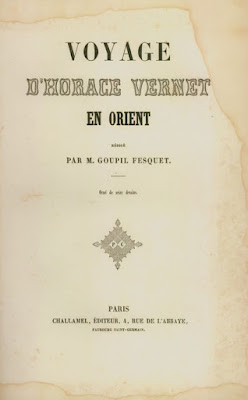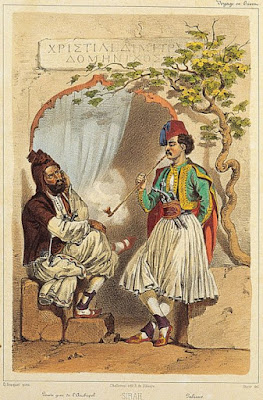 Mavi Boncuk |
Mavi Boncuk | Frédéric Auguste Antoine Goupil-Fesquet (1806-1893) travelled to the East in the company of his uncle, French artist Émile Jean-Horace Vernet (1789-1863), whose father and grandfather were also renowned painters, and of Gaspard-Pierre-Gustave Joly de Lotbinière (1798-1865), who is famous for having taken the first photographs of the Acropolis of Athens and the Pyramids of Egypt. The small party, ideal in number, started out from Marseilles in October 1839. After Malta, they arrived at the island of Syros, of which Goupil-Fesquet describes the marketplace, the port, the mills, the shops and the traditional coffeehouses. The travellers continued on to Santorini, Crete and Smyrna[1], and subsequently visited Egypt (Alexandria, the Nile, Cairo), the Holy Land, Syria, and made a short stay in Constantinople. The party returned to France in February 1840. They intended to print daguerreotypes[2] with views of the East for an important edition with images in this new technique, which was published in Paris in 1842 with the title "Les excursions daguerriennes".
[1] Daguerreotypes which he took of Izmir from the decks of the Iena are mentioned in his diary for 13 February 1840. Since the necessary printing techniques had not yet been developed it was impossible to publish these photographs in books and newspapers. Instead artists copied the photographs for reproduction, adding half-tones and livening them up with the figures of people and animals which were necessarily absent from the scene due to the long exposure period.
[2] Daguerreotype process, or daguerreotypy, was the first publicly announced photographic process, and for nearly twenty years, it was the one most commonly used. It was invented by Louis-Jaques-Mandé Daguerre and introduced worldwide in 1839.By 1860, new processes which were less expensive and produced more easily viewed images had almost completely replaced it. During the past few decades, there has been a small-scale revival of daguerreotypy among photographers interested in making artistic use of early photographic processes.
To make a daguerreotype, the daguerreotypist would polish a sheet of silver-plated copper to a mirror finish, treat it with fumes that made its surface light sensitive, expose it in a camera for as long as was judged to be necessary, which could be as little as a few seconds for brightly sunlit subjects or much longer with less intense lighting; make the resulting latent image on it visible by fuming it with mercury vapor; remove its sensitivity to light by liquid chemical treatment, rinse and dry it, then seal the easily marred result behind glass in a protective enclosure.
SOURCE

Greek pirate of the Aegean. Palicari.
Horace Vernet as he was dressed during his voyage.
Modern female costume of the East. Older female costume from Smyrna.





















































